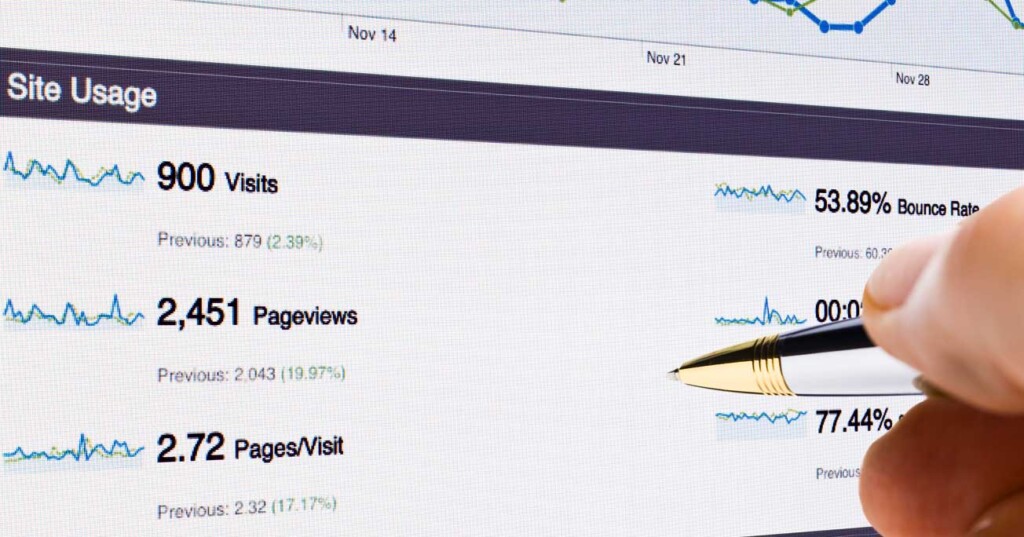
Will a Website Redesign Affect My Search Rankings?
Table of Contents
TLDR
I’ve seen a redesign help rankings if done with care. Audit and preserve top-performing content. Keep or plan redirects for old pages. Speed and mobile-friendliness matter a lot. Watch analytics after launch and fix issues fast. A thoughtful refresh often boosts both user experience and search visibility.
Introduction

I still remember the anxiety that I went through when I needed to update our website back in 2006.
The UI was starting to feel a little dated, and as an agency, we were expected to be at the cutting edge of what was possible to sell to our clients. I had some good search engine rankings, which brought revenue to the agency. My fears were what would happen to my pipeline. We had bills and wages to pay, and the pressure I felt was not insignificant to my much younger self then.
I’m sharing my experience and observations on this topic in this article as I have done this a few hundred times since. I’ll mention real cases, detail pitfalls, and highlight success stories. I aim to give a practical view of how a fresh look can affect SEO performance.
I’ve seen clients improve their website’s search engine rankings soon after launching a redesigned website. I’ve also watched some slips in ranking because they neglected certain technical factors. For me, the key is balancing a pleasing style with solid search practices. If you’re worried about dropping off page one, I get it. I’ve been there, too, and I’m happy to help where possible.
• • •
Defining Website Redesign

Redesigning a website can mean different things to different people. Sometimes, it’s just changing a few colour schemes or adding new graphics. In other cases, it involves a total rebuild, from code structure to page names to the content on each page.
When discussing a site makeover, I think about something bigger than changing the font and header image. If you only swap a few colours, you won’t upset your SEO results too much. But if you switch platforms, move pages around, or shift your entire navigation menu, search engines might treat your new setup almost like a fresh website.
One of my first clients, a local department store in the village where I grew up, decided to modernise its web presence. They moved from a basic HTML site to a full content management system. This gave them new features but also changed most of their URLs. As we are changing a lot of URLs, I knew that unless we utilised 301 redirects from the old page to the new page, they would see a drop in traffic and, subsequently, rankings. Adding 301 redirects is a tedious job, and nobody really puts their hand up for it, but it is necessary and will save you time and money later on.
I usually check the size of the redesign before I predict any effect on search engine optimisation. There’s a big difference between a small facelift and a rebuild from scratch.
• • •
The Connection Between Structure and Rankings

Search engines rely on structured data to determine what your site is about and how pages link. They look at your navigation menu, URLs, and internal linking style. That’s why any significant changes in your layout can affect your ranking.
I’m convinced that site architecture is like the skeleton of a house. Without a clear blueprint, your pages can end up scattered. Search crawlers might have trouble discovering your new structure. You could rank well for a while, but if you move everything around without caution, you might puzzle both bots and human visitors.
I’ve worked on a blog that wanted to group all posts by date rather than topic. They hoped it would look more streamlined. This led to confusion because users were used to browsing by category. As they added more articles to the blog, the older articles were pushed onto pages 3, 4, 5, etc., and this constant change and increased number of clicks the users needed to perform to find the content were detrimental.
This is why we created the content hub approach you are reading about. All content is clearly signposted, grouped, and doesn’t move around. The benefit to the reader’s use experience and the crawler’s accessibility cannot be underestimated.
I like to keep the main categories logical and limit the depth of pages. Nothing should be buried too far in subfolders. If I want users to find something quickly, I keep these essential web pages within two or three clicks from the homepage.
• • •
Preserving Your Existing Content

Existing content often builds the backbone of your site’s credibility on search engines. Blog posts, product pages, service descriptions, and other written resources can become magnets for visitors. If you discard them all in a redesign, you risk wasting months or years of SEO efforts.
Before I perform a site redesign, I ask the SEO team to perform a quick content audit, which includes the following:-
- Which pages attract clicks from the search engine and which do not
- Which pages are being viewed and which do not
- Which pages have content that is still relevant today and which needs to be updated or replaced
- Which pages have backlinks and which do not
- What keywords are attracting and what are your relevant keywords
Creating a spreadsheet of all the site’s pages lets you quickly see what content is working and what you need to decide about.
I often remove pages that do nothing for traffic but rescue articles with promise. If I see a piece that ranks on page two for a decent keyword, I’ll rewrite it for clarity, add more relevant details, and watch it climb to page one.
This is a process I go through for each of my SEO clients when we approach a new website. It’s not quick, but it’s necessary to maintain those valuable search engine results.
• • •
Handling URL Changes
Switching links can be a huge deal. If you overhaul your site’s structure, your old links could suddenly lead to pages that do not exist and give a 404 error. This is why I get uneasy seeing random new URLs unrelated to the old ones.
Broken links annoy visitors and search engines alike. A user clicks on a Google result, lands on a 404 error, and quickly leaves. This can reduce your site’s overall credibility in the eyes of a search engine. It also frustrates anyone who used to visit your pages from external blogs, social media, or email newsletters.
To avoid this, I carefully plan my redirect map. If the new site replaces a page that used to live at /services/web-design with a page at /services/site-design, I’ll put a 301 redirect in place so that Google and users automatically land on the correct new page. A 301 redirect tells search engines that the old page has a permanent new home.
I am currently working with one client who is running a booking platform similar to Airbnb but for fisheries. I performed an SEO analysis of their website and analysed their keyword rankings. I discovered that 90% of their search traffic came from fishery brand terms. However, the URLs for these profiles were not user-friendly, and we are currently considering what we can do to the existing site to make them user-friendly while maintaining SEO rankings. The answer will likely be 301 redirects, but we look at all options.
• • •
Mobile Friendliness and Page Speed
At our agency, in 2016, we saw mobile users overtake desktop users for the first time; this was backed up in October of that year when Stat Counter released their study. An article can be found here: https://techcrunch.com/2016/11/01/mobile-internet-use-passes-desktop-for-the-first-time-study-finds/?t
On July 5, 2024, Google officially dropped its desktop crawler in favour of a mobile-first approach, so the importance of having a mobile site changed forever.
Mobile page speed and user engagement are now more important than ever before. So many times have I created an article or new web page and been so proud of it on my desktop that it is only when I check it on my mobile device that I realise it could be way more friendly.
Slow sites push people away. If you’ve ever tried to load a page on your phone and spent ten seconds waiting, you’ve felt that frustration. That frustration leads to back-button clicks, which can hurt your ranking. To reduce page load time, I often compress images, remove unnecessary scripts, use a content delivery network (CDN) and implement caching.
• • •
SEO Elements to Keep or Update
It’s tempting to revise everything during a redesigning process, including tags, meta descriptions, and headings. Sometimes, though, your existing tags are already doing well. I prefer to keep high-performing titles intact. But if I see outdated or irrelevant wording, I’ll rewrite it.
Title tags remain one of the strongest signals to search engines. Meta descriptions may not directly change rank, but they can boost click-through rates if written well. I like to maintain the same primary keyword focus so I don’t accidentally lose the momentum that page had built.
Header tags (H1, H2, H3) guide readers and search bots through your content. Poorly structured headings make it tough for people to skim and for crawlers to understand. If a redesign changes the look of headings, that’s fine, but I never sacrifice their logical order.
Structured data is another factor—markup for FAQs, Locations, Products, reviews, recipes, or events can help you appear with rich snippets in search results. If you lose that markup during a code rebuild, you might miss out on those eye-catching extras in Google’s listings.
I prefer to do a thorough check right before the launch. I’ll compare the old site’s headings, tags, and structured data to the new site’s. If I spot anything missing or misaligned, I fix it quickly. That small effort can protect the search presence you built over time.
• • •
The Role of User Experience
I have realised that a visitor’s experience directly links to search ranking. If users can’t find what they need, they leave in frustration. That short session length signals potential problems for Google. You are probably reading this on Google Chrome, which is reporting all of your behaviour back to Google to help influence its rankings. How long did you spend on the page, how far down the page did you reach, what elements did you engage with, etc? I believe the strong user engagement signals are a way of bubbling up the content the audience relates to the most.
During a redesign, I pay close attention to the main navigation menu. It should be clear where each link takes you. I avoid burying crucial pages under several layers of submenus. I also want my calls to action to be visible and straightforward.
Readability counts as well. Huge blocks of text can overwhelm. I prefer shorter paragraphs, bullet points, and a few visuals. That approach is friendly for visitors and search bots that parse page structure. I hope we live this advice as you read this and other articles on our site.
• • •
Maintaining Backlinks
backlinks links pointing to your pages can do wonders for search standing. When you revise your site, those inbound links might suddenly send people to missing pages unless you set up proper redirects. That can hurt your credibility and link equity.
I regularly check my clients’ backlink profiles with tools like Ahrefs or SEMrush. I see which pages draw strong inbound links. Then, I protect those pages’ URLs or map them carefully if we change them. We might lose valuable traffic and credibility if high-value pages disappear without any redirects.
If you change your business name or domain, the risks rise even further. You want to let your affiliates and partners know you have a new address. They can update their links. Meanwhile, you should keep a redirect chain from old addresses to the new site. That way, the flow of authority remains intact.
• • •
Tracking and Measuring Performance

A redesign shouldn’t be guesswork. I rely heavily on tracking tools to measure what happens to my traffic after I switch over. Google Analytics is my go-to for user behaviour, and Google Search Console helps me see how impressions and clicks shift over time.
I like to set benchmarks. Before the redesign, I noted my baseline metrics: average search position, bounce rate, organic sessions, and conversion rate. Then, once the new site is live, I track those metrics daily or weekly. If I spot a sudden drop in a specific area, I investigate.
I am currently working with a wholesaler of goods in the fishing tackle sector who changed their domain name in 2023. While every best practice was undertaken to preserve ranking, it still took them a year to return to the traffic levels before.
I also monitor mobile performance and site speed metrics right after launch. Sometimes, a fancy redesign can be code-heavy. If load times spike, visitors may leave quickly. I can fix any issues early by staying alert and reducing ranking damage.
A redesign is a process, not a one-time event. If I see signals of trouble, I pivot. That’s how I’ve saved clients from deeper ranking slides.
• • •
Common Pitfalls and How I Avoid Them
One of the biggest pitfalls is forgetting about technical SEO. I’ve seen a site launch with beautiful images and neat text without proper meta tags or headings. Sometimes, people skip the alt text on images. That might not sound major, but search engines care about these signals.
Another trap is ignoring user input after the redesign. I always watch the site’s analytics and listen to feedback. If visitors say something’s hard to find, that’s my cue to rearrange or rename it. If a redesign confuses customers, they leave. That bounce can drag down your ranking.
There’s also the risk of slower page speed. Some new themes come with bulky scripts and heavy plugins, which are easy to miss if you look at your local version. I test speeds on real devices, not just in my developer environment.
I also avoid launching a new site without solid testing. I run staging environments where I can spot broken links. I do my best to confirm that the main features work across desktop and mobile. This approach has saved me from pushing out code that breaks fundamental pages.
A final pitfall involves ignoring a step-by-step plan. If you switch everything in one day, you might struggle to find and fix what caused a problem. I prefer a phased approach, especially for large sites. If something goes wrong, you only have to backtrack on a small part rather than the entire redesign.
• • •
Real-World Examples
My advice would be meaningless if I did not practice what I preached, so it would be remiss of me to use this section to discuss my agency’s site.
At Ronins, we started off using Google PPC to generate instant leads. However, this was getting more expensive as more and more people saw PPC as a means of instant gratification, and the spending was unsustainable for our situation at the time. (For example, we spent £30k a month on PPC at my last agency; I have heard this has tripled in the last couple of years.)
So, we started an SEO strategy to supplement our lead generation while networking like crazy. We redesigned our website from an off-the-shelf template into a custom build on WordPress using ACF blocks, ruthlessly focusing on user experience, indexability, and page speed.
We did not have any organic traffic to worry about, and with the help of tools like aHrefs, we quickly learnt that we were creating articles without performing any keyword research. In effect, we were publishing and preying.
We set about building out our content hub, where this article is found. We started again from scratch; each article was re-written, new images were found, and we even added Spotify to our articles so that our audience could listen to them over reading. We gave our users a choice.
This felt like a never-ending trudge of article writing without any traffic. In fact, it took about 6 months to see something and about a year to see any real tangible benefits. The good thing about writing good-quality articles is that their impacts compound over time, unlike PPC, where it’s like a tap turning it off, and the traffic stops.
Yes, we have made mistakes along the way. We are only human. Yes, Google has changed the rules a few times, too, as it dealt with the tsunami of AI-generated content flooding the internet. But you only learn from failure, not success, and that line from the 2005 movie Batman Returns, “Why do we fall, Bruce? So we can pick ourselves up,” is so true when you engage with search engine optimisation.
We are now starting our third year of SEO and regularly appear on the first pages for our service pages locally. A few are on the first page nationally / globally. We need to keep up the cadence of articles and perform regular monitoring and maintenance, and the compound effect will take care of itself.
• • •
My Step-by-Step Redesign Checklist

Over time, I’ve created a personal list of tasks that I check whenever I’m revamping a site. Here’s the rundown:
- Audit Content and Performance
- Identify top-ranking pages and best-performing articles.
- Highlight content that still has potential.
- Decide which pages to merge, rewrite, or remove.
- Plan Information Architecture
- Organise main categories and subcategories.
- Keep navigation user-friendly with minimal click-depth
- Use descriptive labels for menu items
- Set Up Redirects
- Map old URLs to their corresponding new addresses.
- Use 301 redirects for permanent page changes.
- Test for broken links before launching.
- Optimise for Mobile
- Adopt responsive templates or frameworks.
- Use real mobile devices or mobile simulations to spot layout issues.
- Compress images and reduce script bloat for faster load times.
- Review SEO Essentials
- Keep or improve title tags, meta descriptions, and alt text.
- Maintain or restore headings and internal linking.
- Validate any structured data or schema markup
- Monitor Analytics
- Compare pre- and post-launch metrics.
- Watch for dips in traffic or a spike in 404 errors.
- Investigate any sudden position changes for important keywords.
- Iterate and Tweak
- Gather feedback from real users.
- Resolve layout problems and fix code issues.
- Make small improvements over time rather than waiting for one giant fix.
This is the structure I follow. It’s served me well across various projects.
• • •
My Personal Opinion on Redesign and SEO
I think a website redesign is an opportunity, not an automatic liability. A fresh look can attract new visitors, increase conversions, and show you’re evolving. But it’s essential to go about it in a measured way.
In my experience, panic only results from a lack of planning. You might lose ground if you tackle a redesign without mapping your key pages, checking your existing SEO signals, or preparing for mobile responsiveness. Fear of losing rank shouldn’t stop you from modernising your online presence.
I weigh the pros and cons. If my site runs on old code, has poor user experience, or fails on mobile screens, then clinging to my current rank might hold me back in the long run. I’d instead take the leap, do it carefully, and come out ahead. Yes, there might be a temporary dip in rank, but if the result is a faster, more logical site, there’s a good chance you’ll climb again.
Balancing design and function is key. I see them as partners rather than enemies. I recommend always letting the user experience drive the technology and stealing a phrase from the 1999 movie Field of Dreams: ” If you built it, they will come.”
• • •
Frequently Asked Questions and Misconceptions
Q1: Will my rankings always drop right after a redesign?
I’ve found that a small dip in traffic can happen while Google re-crawls your site. That doesn’t always mean a permanent drop. If you’ve taken care of redirects, kept valuable content, and ensured mobile speed, you’ll likely bounce back or move higher.
Q2: Do I need a new domain name for a redesign?
In my opinion, switching domains only makes sense if you’re rebranding. Otherwise, keep your existing domain. Changing it creates extra work with redirects, and it can temporarily unsettle your authority in search.
Q3: Can I maintain my old URLs even if the design changes?
Yes, you often can. The design or platform might look and function differently, but you can keep the same URL structure. This helps preserve links, though it depends on how drastically you’re rebuilding.
Q4: Is a complete content overhaul always needed?
I don’t think so. Some redesigns may only need slight content updates. If a page is already performing well, keep its core intact. Add new info or refresh outdated sections rather than starting from scratch.
Q5: Won’t a new fancy theme automatically fix my SEO issues?
A nice template can help with layout and responsiveness, but SEO depends on more factors—titles, headings, site speed, redirects, and quality content matter too. A theme alone won’t carry your ranking.
Q6: Should I pause my marketing campaigns until my new site is live?
I’d only pause them if your site has serious technical issues or if visitors will encounter broken pages during the transition. Otherwise, you can continue marketing while you carefully implement changes.
Q7: Will a faster site guarantee a page-one rank?
Speed is a major ranking factor, but it’s one part of the bigger puzzle. A lightning-fast site needs relevant content, quality links, and user-friendly navigation to reach and hold top spots.
Many people assume a redesign always crushes their ranking. In my view, it’s more about the details. If you handle things properly, you can keep or improve your position. A redesign is a chance to refine your approach rather than reset everything.
• • •
Conclusion and Final Thoughts
So, does a website redesign affect your search rankings? In my view, the impact can be positive or negative. It’s how you approach it.
A site refresh can help you adopt modern design principles, speed up load times, and refine your content, which can win you more attention from search engines. But a sloppy overhaul that breaks old links deletes valuable content or ignores mobile experience can cost you dearly.
The best approach is to treat your redesign like a journey, not a quick fix. Start by auditing your content. Protect or map your most powerful pages. Prepare for URL changes. Watch your data after launch. If you see problems, don’t panic; address them as soon as possible.
I like to remind people that a short-term drop can happen, even if you do everything right. Google may need time to adjust to your new structure. But you should regain momentum if you’ve retained your best material, used proper redirects, and improved speed and mobile use. Often, you’ll end up better off than you were before.
I hope my stories and observations have offered clear, direct advice. A well-planned redesign can keep your visitors happy and your ranking safe. Don’t fear a fresh look. Embrace it with a careful plan, and you’ll likely see stronger performance in the end.
Thanks for reading, and good luck with your changes!
• • •





